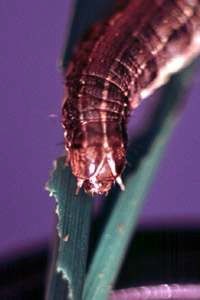Fall Armyworms on Turf
Though we had some fall armyworms last year, the last time we had a significant outbreak on turf was August, 2000. Armyworms are so-called because they invade fields or landscapes as large groups and can cause a lawn to turn brown seemingly overnight.
Young worms are ½ to 3/4 inch long. Mature ones are 1 ½ inches long. Body color may vary from green to almost black but light stripes will be visible along the length of the body. Look for a whitish inverted “Y” on the top of the black head. It normally takes 2 to 3 weeks to progress from egg to pupa. The adult is a moth.
Armyworm damage can resemble drought damage but close inspection of the turf will reveal the larvae. Look for active feeding during early morning or evening hours or on cloudy days. Larvae feed on foliage and the resulting dehydration
causes to turf to quickly brown. Normally, armyworm damage does not kill established turf but may if populations are high enough. Thick infestations of fall armyworm can damage turfgrass crowns which will kill turf.
Carbaryl (Sevin), acephate (Orthene, Acephate), spinosad (Conserve; Captain Jack’s Dead Bug Brew; Borer, Bagworm, Leafminer and Tent Caterpillar Spray) and other insecticides are effective caterpillar killers. Treat in late afternoon, when the caterpillars are likely to begin feeding. Do not mow for 3 days after treatment.
Young worms are ½ to 3/4 inch long. Mature ones are 1 ½ inches long. Body color may vary from green to almost black but light stripes will be visible along the length of the body. Look for a whitish inverted “Y” on the top of the black head. It normally takes 2 to 3 weeks to progress from egg to pupa. The adult is a moth.
Armyworm damage can resemble drought damage but close inspection of the turf will reveal the larvae. Look for active feeding during early morning or evening hours or on cloudy days. Larvae feed on foliage and the resulting dehydration
causes to turf to quickly brown. Normally, armyworm damage does not kill established turf but may if populations are high enough. Thick infestations of fall armyworm can damage turfgrass crowns which will kill turf.
Carbaryl (Sevin), acephate (Orthene, Acephate), spinosad (Conserve; Captain Jack’s Dead Bug Brew; Borer, Bagworm, Leafminer and Tent Caterpillar Spray) and other insecticides are effective caterpillar killers. Treat in late afternoon, when the caterpillars are likely to begin feeding. Do not mow for 3 days after treatment.
(Ward Upham)
http://www.ksuhortnewsletter.org/




Leave a Reply
You must be logged in to post a comment.